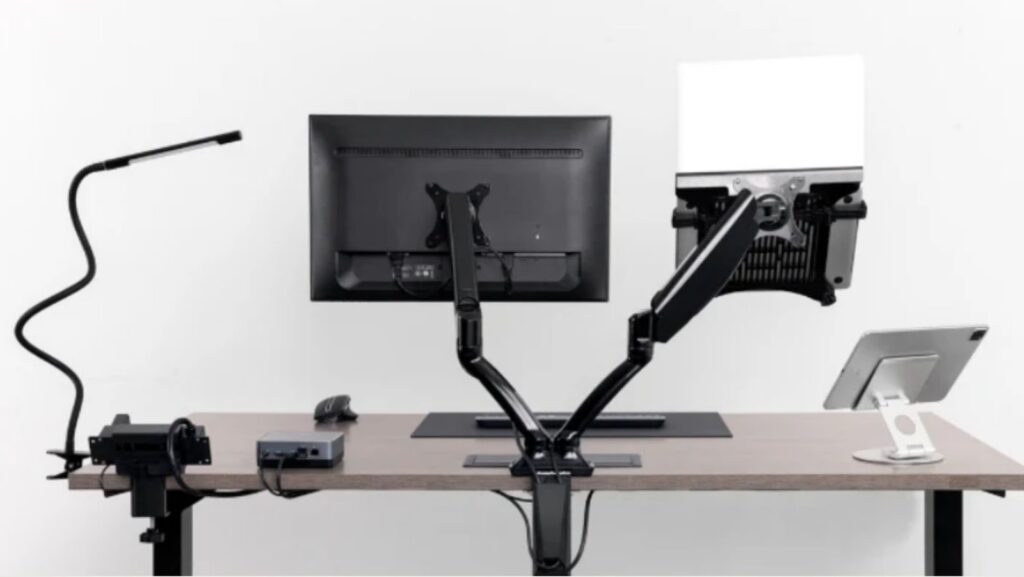
Do you feel cramped at your desk? Do you experience neck and shoulder pain after long hours spent staring at your screen? A monitor mount might be the perfect solution to transform your workspace and improve your ergonomics. Explore the world of monitor holders, learn their benefits, functionalities, and how to choose the perfect one for your setup.
Imagine transforming your workspace into a clutter-free haven of productivity with the addition of a sturdy and stylish monitor mount. These innovative tools lift your screen to eye level, reducing strain on your neck and shoulders and maximizing desk space for a more organized setup. A well-chosen monitor mount can add functionality and aesthetics to your work environment.
Benefits of Using a Monitor Mount
Here is how this device can revolutionize your work environment:
#1. Improved Ergonomics and Comfort
Monitor support empowers you to create an ergonomic workstation. By raising your screen to eye level, you can alleviate neck strain and improve posture. Many holders offer tilt, swivel, and pivot adjustments, allowing you to find the perfect viewing angle for optimal comfort.
#2. Save Desk Space and Increase Productivity
Traditional monitor bases can devour valuable desk real estate. Screen brackets free up precious workstation space. It allows for improved organization, additional equipment, and a more spacious working environment, ultimately leading to increased productivity.
#3. Achieve a Cleaner and Organized Workspace
Monitor holders help declutter your workspace. By elevating your monitor and managing cables (more on that later!), they contribute to a clean and organized aesthetic. It enhances focus and reduces visual clutter, fostering a more productive environment.
Types of Monitor Mounts: Finding the Perfect Fit
There are several types of these devices available:
· Desk holders. These devices are attached to your desk’s surface with a clamp or grommet mount. They offer a good range of adjustability for height and tilt but may not extend as far as arm mounts.
· Wall mounts. Ideal for limited work setup space, they secure your screen directly to the wall. They offer a wide range of motion for positioning and are perfect for sit-stand desks. However, installation might require drilling into the wall.
· Grommet mounts. These devices utilize a grommet hole in your workstation for a clean and sturdy installation. They offer similar functionalities as desk clamps but provide a more streamlined look.
· Monitor mount arms. It is the most versatile option. It offers the greatest range of adjustability. These arms can extend, tilt, swivel, and rotate your screen, allowing you to find the perfect viewing angle with ease.
Features and Functionalities
Each device type offers specific functionalities:
· Desk and grommet solutions usually focus on height adjustment with some offering limited tilt or swivel.
· Wall devices prioritize a sleek look with limited adjustability.
· Monitor mount arms are the most feature-rich option. They offer versatile adjustments for optimal viewing angles and ergonomics.
Factors to Consider When Choosing the Right Option
Before you start shopping, consider these key factors:
Compatibility with Your Screen
Ensure the screen you choose is compatible with your screen’s VESA (Video Electronics Standards Association) mounting pattern.
This standardized system ensures compatibility between screens and arms. Most displays have a 75mm x 75mm or 100mm x 100mm VESA pattern, usually located on the back of the screen.
Adjustability and Flexibility
Desk holders offer basic adjustments, while arm mounts provide the most flexibility. Consider how you want to position your monitor and choose a holder that offers the necessary adjustments.
Weight Capacity and Stability
Make sure the chosen option has a weight capacity exceeding your screen’s weight. Consider the size and material when assessing weight. Choose a device with a sturdy base or clamp for optimal stability.
Cable Management Features
Look for a solution with built-in cable management features, such as channels or clips, to keep cords organized and hidden from view.
Installation and Setup Tips for Your Monitor Mount
Most screen holders are straightforward to install, but having a clear guide can make the process smooth sailing.
Tools Needed
In most cases, you will need a screwdriver and a wrench. Installing advanced options might require additional tools, but the manufacturer’s instructions will outline those necessities.
Step-by-Step Installation Guide
· Gather your tools and consult the manufacturer’s instructions. Each mount might have different installation steps.
· Assemble the mounting bracket according to the instructions.
· Attach the monitor support adapter to your monitor. This adapter plate screws onto the back of your monitor using the VESA mount points.
· Mount the base of the screen holder to your desk (for desk mounts) or wall (for wall mounts). Securely fasten the base using the provided screws or hardware.
· Attach your screen to the display support arm using the quick-release mechanism or screws (depending on the mount).
· Adjust the height, tilt, and swivel of your display to achieve the optimal viewing angle. Refer to the manufacturer’s instructions for specific adjustment mechanisms on your mount.
· If your mounting device has built-in cable management features, utilize them to route and hide your cables for a clean look. Consider using zip ties or cable sleeves for additional cable organization.
Pro tip. Before setting your screen, take some time to experiment with different heights and angles. Find the sweet spot that provides optimal comfort and minimizes strain on your neck and eyes.
Stylish Options to Complement Your Workspace Aesthetics
Modern options come in different styles and finishes:
· For a modern and streamlined look, choose a monitor mount with clean lines and a thin profile. Black and silver colors will blend into your existing setup.
· If you prefer a pop of color, some screen holders offer options like white, rose gold, or even bold accent colors. Choose a finish that complements your desk, chair, or other workspace accessories.
· Many screen holders integrate with other desk accessories (e.g., keyboard trays, and laptop stands), creating a cohesive and appealing workspace.
Incorporating a monitor mount into your workspace enhances comfort, efficiency, and aesthetics. With various types and features, finding the right monitor mount can optimize your setup for a more productive and enjoyable work experience.






